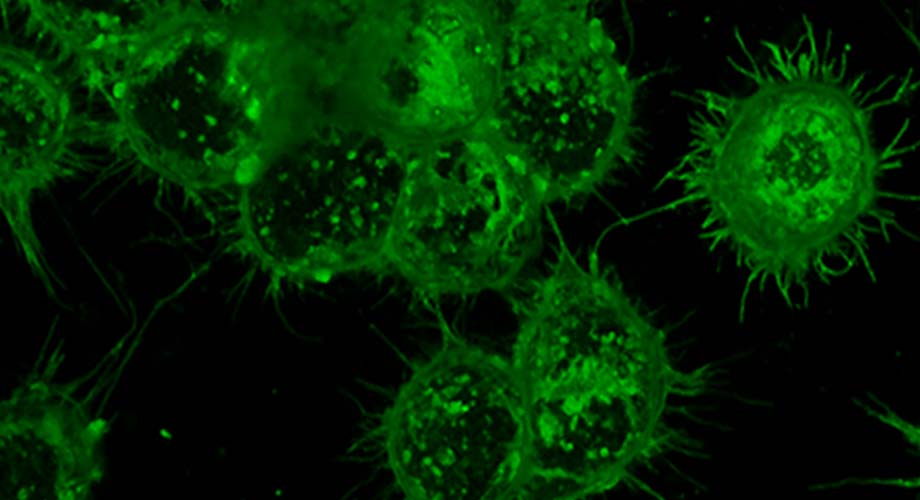
A heavy layer of glycans, seen here in green, cover immune cells and provide a way to target cancer-specific markers in the body. (Image courtesy of Senlian Hong, Wu Lab at Scripps Research.)
Potential treatment approach kills lymphoma while sparing healthy cells
Scientists use a novel method of modifying “killer” immune cells to defeat a common form of cancer.
December 14, 2020
LA JOLLA, CA—Scientists at Scripps Research have demonstrated a promising new strategy for treating lymphomas, a group of cancers that begin in infection-fighting cells of the immune system called lymphocytes.
The new approach uses natural cancer-targeting immune cells, known as natural killer cells, that have been modified to selectively target lymphoma. As described in their study, published in the journal Angewandte Chemie, the modified natural killer cells brought about a dramatic reduction of lymphoma in a mouse.
“We found a way to achieve selectivity in targeting lymphoma cells, which is an important departure from existing therapies,” says co-senior author Peng Wu, PhD, an associate professor in the Department of Molecular Medicine at Scripps Research.
Wu and his lab collaborated in the study with the lab of co-senior author James Paulson, PhD, the Cecil H. and Ida Green Professor and Chair of the Department of Molecular Medicine at Scripps Research.
More than 20,000 people in the United States die of lymphomas annually, while approximately 85,000 people are newly diagnosed. Most lymphomas arise from B cells, an important type of lymphocyte whose primary function is to make antibodies.
Some existing lymphoma treatments, including B-cell-killing antibodies and so-called CAR-T cell therapies, work by targeting B cells indiscriminately, largely wiping them out. However, this strategy brings many adverse side effects, including months of immunosuppression due to low antibody levels.
Wu, Paulson and their teams have developed a more specific approach using natural killer cells, which are immune cells that normally patrol the bloodstream and tissues, seeking and destroying virus-infected or cancerous cells. These immune-system warriors, also known as NK cells, are able to recognize certain tell-tale surface molecules that signify serious damage or malignancy within a cell; they can then kill that target cell through a variety of means, including by secreting proteins that punch holes in the cell’s outer membrane.
Creating a super-powered NK cell
In the early 1990s, Canadian researchers developed a special type of NK cell, NK-92, from a patient with a rare NK-cell cancer. NK-92 cells are relatively easy to grow and multiply in the lab, compared with normal NK cells found in human blood.
The Canadian researchers and others have since shown that NK-92 cells are good at killing different kinds of cancerous cells, and can bring about dramatic results in some patients, with minimal side effects. NK-92MI cells, an easier-to-multiply version of NK-92 cells, are now being widely investigated for use against various cancers.
On their own, NK-92MI cells may not be ideal cancer-fighters, especially not for advanced malignancies, in part because they are dispersed throughout the body when infused into the bloodstream. In the new study, however, Wu and his team used chemistry techniques to modify NK-92MI cells to concentrate their cancer-fighting power against lymphoma.
Steering powerful cells where they’re needed most
In an initial set of experiments, the Scripps Research scientists re-engineered NK-92MI cells to include a surface molecule that binds to a B-cell surface receptor called CD22, which is normally abundant on B-cell-derived lymphoma cells. Thus, in principle, the NK-92MI cells would selectively recognize cancerous B cells.
In cell-culture tests, the modification brought a big improvement in the NK cells’ ability to kill lymphoma cells, and these killer cells did not harm healthy cells. In a mouse model of lymphoma, however, the strategy didn’t work so well, apparently because the NK cells still did not go where they were needed.
“We found that after being injected, these NK cells tend to be found in the lungs and throughout the bloodstream—whereas in this mouse model and in human lymphoma patients, the lymphoma cells are mostly in the bone marrow,” Wu says.
The team then added to their NK cells a new molecule called Sialyl-Lewis X, which made the cells gather in bone marrow amid the lymphoma cells. This led to a dramatic delay in the development of lymphoma in the mice. With this promising result, Wu and his lab now are continuing to develop this and related strategies for clinical use.
Wu and Paulson suspect that in general, adding homing molecules such as Sialyl-Lewis X to cell-based anticancer treatments enhances the cancer-killing power at the site of the cancer, and may be a key to these treatments’ future success—particularly against solid tumors and other highly localized cancers.
Wu notes, too, that Sialyl-Lewis X, which made the NK-92MI cells gather in bone marrow, as well as the CD22-binding molecule that directed the cells to malignant B cells, are both sugar-like “glycan” molecules. Although such molecules are found on virtually all cells, and often have essential biological functions as well as crucial roles in disease, they are difficult to study and thus have been relatively neglected.
“People are only starting to appreciate the importance of glycans,” says Senlian Hong, PhD, the first author of the study and a postdoctoral research associate in the Wu lab at Scripps Research.
The study, “Glycoengineering of NK cells with glycan ligands of CD22 and selectins for B-cell lymphoma therapy," was authored by Senlian Hong, Chenhua Yu, Peng Wang, Yujie Shi, Weiqian Cao, Bo Cheng, Digantkumar Chapla, Yuanhui Ma, Jie Li, Emily Rodrigues, Yoshiki Narimatsu, John Yates III, Xing Chen, Henrik Clausen, Kelly Moremen, Matthew Scott Macauley, James Paulson and Peng Wu.
Funding was provided by the National Institutes of Health (R01AI143884, R01GM113046, P41GM103390, P01GM107012, R01GM130915, R01AI050143, P01HL107151, U19AI136443) and the Danish National Research Foundation (DNRF107).
For more information, contact press@scripps.edu

